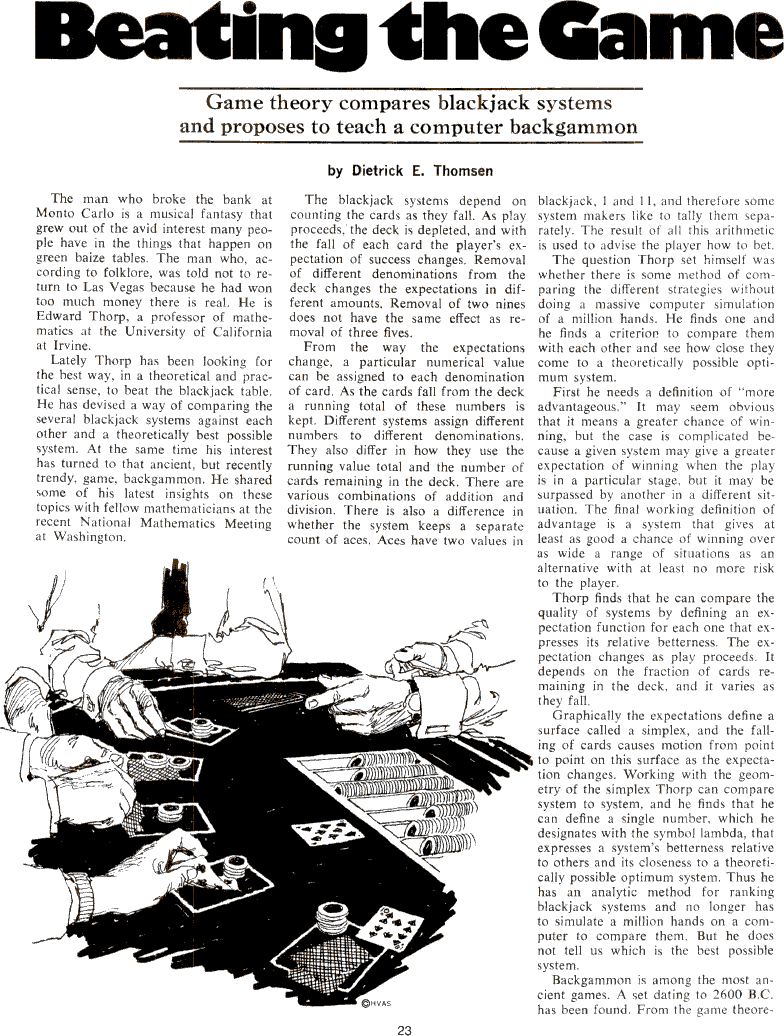by Deitrick E. Thomsen

BEATNG THE GAME Game theory compares blackjack systems and proposes to teach a computer backgammon The man who broke the bank at Monto Carlo is a musical fantasy that grew out of the avid interest many people have in the things that happen on green baize tables. The man who. according to folklore. was told not to return to Las Vegas because he had won too much money there is real, He is Edward Thorp, a professor of mathematics at the University of California at Irvine. Lately Thorp has been looking for the best way, in a theoretical and practical sense, to beat the blackjack table. He has devised a way of comparing the several blackjack systems against each other and a theoretically best possible system. At the same time his interest has turned to that ancient, but recently trendy, game, backgammon. He shared some of his latest insights on these topics with fellow mathematicians at the recent National Mathematics Meeting at Washington. [Image]© HVAS 23 The blackjack systems depend on counting the cards as they fall. As play proceeds. the deck is depleted, and with the fall of each card the player's expectation of success changes. Removal of different denominations from the deck changes expectations in different amounts. Removal of two nines does not have the same effect as removal of three fives. From the way the expectations change, a particular numerical value can be assigned to each denomination of card. As the cards fall from the deck a running total of these numbers is kept. Different systems assign different numbers to different denominations. They also differ in how they use the running value total and the number of cards remaining in the deck. There are various combinations of addition and division, There is also a difference in whether the system keeps a separate count of aces. Aces have two values in blackjack. l and l l, and therefore some system makers like to tally them separately. The result of all this arithmetic is used to advise the player how to bet. The question Thorp set himself was whether there is some method of comparing the different strategies without doing a massive computer simulation of a million hands. He finds one and he finds a criterion to compare them with each other and see how close they come to a theoretically possible optimum system. First he needs a definition of "more advantageous." It may seem obvious that it means a greater chance of winning, but the case is complicated because a given system may give a greater expectation of winning when the play is in a particular stage, but it may be surpassed by another in a different situation. The final working definition of advantage is a system that gives at least as good a chance of winning over as wide a range of situations as an alternative with at least no more risk to the player. Thorp finds that he can compare the quality of systems by defining an expectation function for each one that expresses its relative betterness. The expectation changes as play proceeds. It depends on the fraction of cards remaining in the deck, and it varies as they fall. Graphically the expectations define a surface called a simplex, and the falling of cards causes motion from point to point on this surface as the expectation changes. Working with the geometry of the simplex Thorp can compare system to system, and he finds that he can define a single number, which he designates with the symbol lambda, that expresses a system's betterness relative to others and its closeness to a theoretically possible optimum system. Thus he has an analytic method for ranking blackjack systems and no longer has to simulate a million hands on a computer to compare them. But he does not tell us which is the best possible system. Backgammon is among the most ancient games. A set dating to 2600 B.C. has been found. From the game theore

